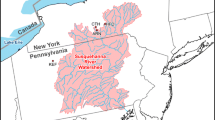Abstract
Two atmospheric diffusion models, the box model ad the ATDL (Atmospheric Turbulent and Diffusion Laboratory) model, were used to calculate regional methane (CH4) emissions of rice fields in the Beijing area. Compared with conventional closed chamber measurements, the box model overestimated CH4 emission because of meteorological conditions--the ground inverse layer was not favorable for the application of the model during the rice-growing season. The ATDL model, on the other hand, handled this unfavorable meteorological condition and gave reasonable CH4 emission estimates (about 6.1–8.5 mg m−2 h−1) close to conventional measurements (about 0.3–14.3 mg m−2 h−1) in June, a period generally characterized by significant CH4 emission from rice fields. In September, CH4 emission as measured with closed chambers was negligible (about 0–0.3 mg m−2 h−1), but the ATDL model still calculated it to be about 2.8–5.3 mg m−2 h−1, albeit at a low level and considerably below the June emission level. This discrepancy cannot be explained at present and needs further stuy. Most likely causes are measurement artifacts and/or the presence of minor local CH4 sources (ditches, field depressions) in the study area. The application of atmospheric diffusion models for regional CH4 emission estimation depends greatly on meteorological conditions. Moreover, the models tend to give much more reliable results during periods of rather high CH4 emission. This coincides with the time that such regional CH4 emission estimates are most valuable. The atmospheric diffusion models complement the closed chamber method by providing integrated CH4 emission estimates from 1–100-km2 rice areas. Detailed information about agricultural management of rice fields and other potential CH4 sources within the study region are necessary to better understand the integrated regional emission estimates.
Similar content being viewed by others
References
Aselmann I & Crutzen PJ (1990) A global inventory of wetland distribution and seasonality, net productivity, and estimations. In: Bouwman AF (ed) Soils and the Greenhouse Effect, pp 441–449, John Wiley, New York
Bachelet D & Neue HU (1993) Methane emission from wetland rice areas of Asia. Chemosphere 26:219–237
Cao MK & Dent JB ( 1995) Modeling CH4 emissions from rice paddies. Global Biogeochem Cycles 9 (2):183–195
Cicerone RJ & Oremland RS (1988) Biogeochemical aspects of atmospheric methane. Global Biochem Cycles 2( 4): 299–327
Czpiel PM et al (1996) Landfill methane emissions measured by enclosure and atmospheric tracer methods. J Geophys Res 101:D11, 16711–16719
Denier van der Gon HAC & Neue HU (1995) Influence of organic matter incorporation on the methane emission from a wetland rice field. Global Biogeochem Cycles 9: 11–22
Folorunso OA & Rolston DE (1984) Spatial variablity of field measured denitrification gas fluxes. Soil Sci Soc Am J 43:89–95
Hanna SR & Steven R (1982) Handbook on atmospheric diffusion. Technical Information Center, U.S. Department of Energy
Khalil MAK & Rasmussen RA (1993) The methane sources in China, historical and current emissions. Chemosphere 26(1-4):127-142
Khalil MAK, Rasmussen RA, Shearer MJ, Dalluge R W, Ren Lixin & Chang-lin Duan (1998) Factors affecting methane emissions from rice fields. J Geophys Res 103:D19, 25219–25231
Pasquill F (1961) The estimation of the dispersion of windborn material. Meteorol Mag 90:33–49
Shao KS (1993) Preliminary study on the relationship of agricultural practices on mehane emission flux from rice paddy near Beijing area. Rural Eco-Environ 35 (in Chinese)
Shorter JH et al. (1996) Methane emission measurements in urban areas in eastern Germany. J Atmos Chem 24:121–140
Shurpali NJ, Verma SB, Clement RJ & Billesbach DP (1993) Seasonal distribution of methane flux in a Minnesota peatland measured by eddy correlation. J Geophys Res 98:D11, 20649–20655
Simpson IJ, Thurtell GW, Kidd G E, Lin M, Demetriades-Shah TH, Flitcroft ID, Kanemasu ET, Nie D, Bronson KF & Neue HU (1995) Tunable diode laser measurements of CH4 fluxes from an irrigated rice paddy field in the Philippines. J Geophys Res 100:D4, 7283–7290
Veltkamp AC, Vermeulen AT, Kieskamp WM & Van Den Bulk WCM (1995) Source apportionment studies of atmospheric methane at two monitoring stations in the Netherlands (Progress Report 1990-1994), ECN-C--95-034
Walter BP, Heimann M, Shannon RD & White JR (1996) A process-based model to derive methane emissions from natural wetlands. Geophys Res Lett 23 (25):3731–3734
Wang ZY et al. (1997) Integrated report of IRRI-UNDP methane projects in Beijing. Paper presented at the In-house Review and Evaluation of the Methane Project in China, 08-10 Dec 1997
Wang MX, Shangguan WQ & Shen RX (1993) Sources of methane in China: rice fields, agricultural waste treatment, cattle, coal mines, and other minor sources. Atmos Sci 17:5 (in Chinese)
Author information
Authors and Affiliations
Rights and permissions
About this article
Cite this article
Liu, J., Zhang, Y., Shao, K. et al. Estimation of Regional Methane Emission from Rice Fields Using Simple Atmospheric Diffusion Models. Nutrient Cycling in Agroecosystems 58, 303–310 (2000). https://doi.org/10.1023/A:1009815223989
Issue Date:
DOI: https://doi.org/10.1023/A:1009815223989




